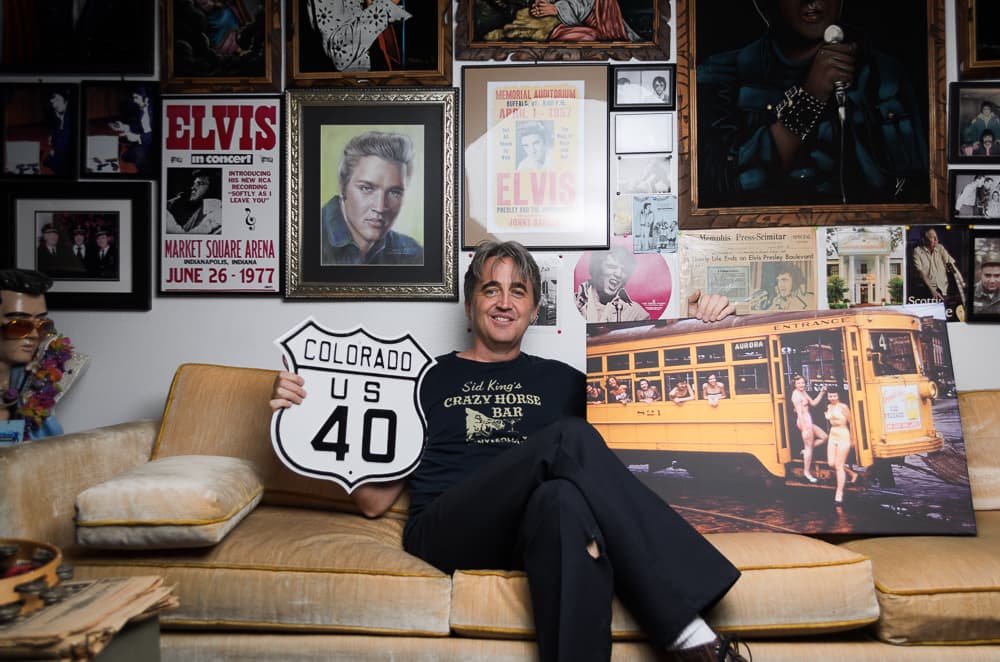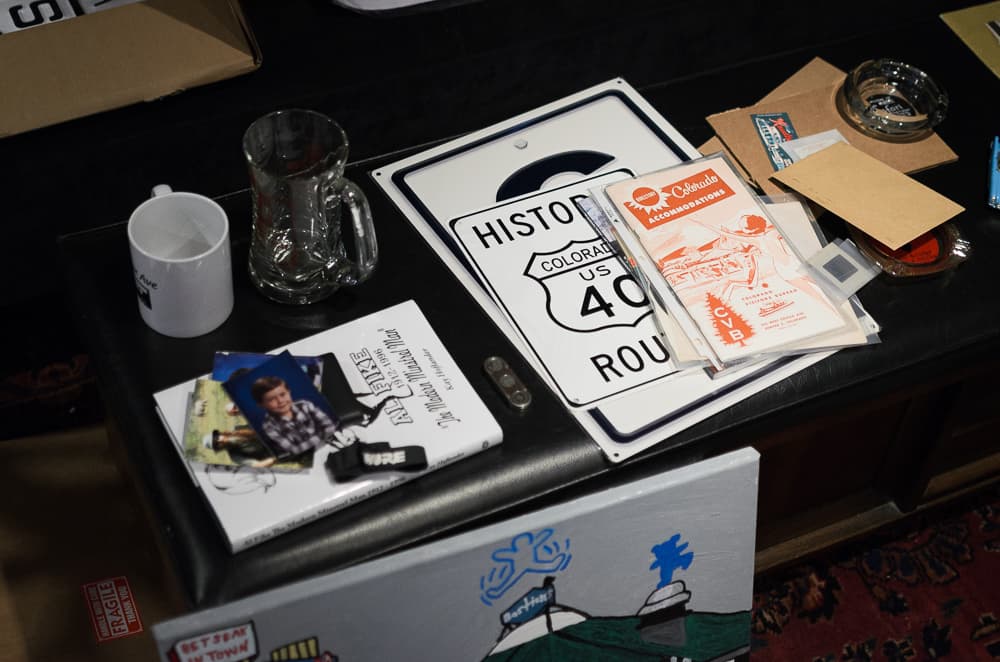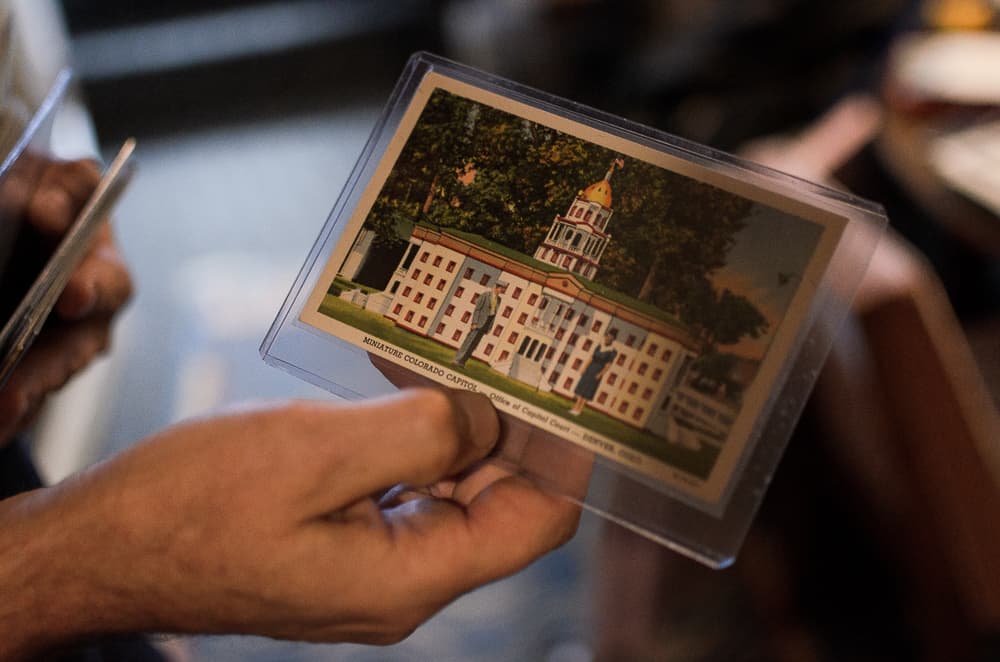
I called up Jonny Barber because the man who dedicated 14 years of his life to painstakingly chronicling all things Colfax had just posted a note on his website, ColfaxAvenue.com, that he was calling it quits and looking for an investor to turn his large collection of Colfax memorabilia into a museum.
This seems like it should be a straight-forward interview and a straight-forward story, but five minutes into our conversation, we're both questioning the nature of reality. How do we know things are true? Is anything true? Does it even matter?
"You have all these stories: Bob Dylan at the Satire, he goes in there thinking he’s Woody Guthrie and they boo him off the stage and he leaves all dejected. Well, I had a guy write me on my Facebook page the other day and say it’s total bullshit. And everyone defends it like it’s the Holy Scripture, this sacred cow! 'Of course Dylan played there! Of course that happened!' And this guy was like, ‘I was there the whole time, I lived there the whole time, and Dylan was never there. It’s completely fake news. It’s complete bullshit.’
"And everyone defends it! I was defending it, and I didn’t even have a source!"
I ask Barber if these doubts have just started to creep in recently. We've already discussed the infamous quote about Colfax, "the longest, wickedest street in America" that supposedly appeared in Playboy at some point. Barber has sought in vain for the original, and my colleague Andrew Kenney is coming up empty too.
"It’s been way recent!" Barber practically yells. "I’ve been No. 1 Colfax booster for 14 years and all of a sudden ... Most stuff, when I post it, I like to have citation, but you figure if something is on the Denver Public Library site, maybe they researched it, and so many people said that Playboy quote. That was in the New York Times. ‘Playboy magazine said this.’ Well, did they?
"Do we even know what’s real? Do we have to rethink all this? Or do we not? Do we just keep the mythology alive and let it be? Let that be the myth. ‘Oh, yeah, Bob Dylan played there when he was 19.' Put a plaque up. Do we just commit at this point?"
So many things that are true about Colfax seem like they shouldn't be that it's not hard to see how the street generates its own legends. Barber had heard about a supposed alligator farm on Colfax that featured gator wrestling as family entertainment, and he put his allies in the Aurora History Museum on the hunt. Months later, he got an excited email and a fairly strong piece of evidence in the form of a newspaper advertisement.
"I just found out about the gator farm last week," he says. "No one knew! Colfax historians, Denver library, nobody knew about the gator farm. ... The gator farm is real. And I found an old-timer who remembers going there, and they had gator-wrestling every hour on the hour. Bring the family. Kids six and under free. The gators are hungry.
"So that’s where you go, is that urban legend? Is that myth? And we found an old newspaper article advertising the gator farm."
Barber loves to tell the story of his introduction to Colfax. A professional musician his entire life, Barber was driving into Denver to play a gig at the Lion's Lair.
"And I get shot at on my way into town. This is my first time in Denver, and I get shot at in my car. I didn’t do anything. I didn’t cut anyone off. I was just holding the slow lane minding my own business, and some car comes whipping up behind me, pulls alongside me, pops a couple caps in my van, and speeds off. I’m like, ‘Whoa, welcome to Denver.’
"And then we’re driving down Colfax, and it’s like, whoa, den of iniquity. Hookers everywhere. ... They weren’t really hiding out.
"So I pull up to the Lion’s Lair to do the gig, and there are two guys having sex in the dumpster. In the dumpster! I’m from Salt Lake! I’ve never seen anything sort of like that. There’s a pregnant woman doing crack in the bushes. There’s guys doing whatever. We go in, and we play the gig. We’re loading the gear like, someone keep an eye on the van at all times. It was kind of scary. But at the same time, it was kind of exciting. Because we were young guys and I had read Kerouac and I knew he’d talked about Colfax in On the Road. I don’t think Colfax was maybe quite like this in the 40s."
(The other Colfax story that leaves Barber exclaiming, "I'm from Salt Lake!" has to do with trains.)
Barber later ended up living in an apartment on Vine Street in a converted mansion just off Colfax, and like so many people, he was captivated by the dichotomy of Colfax and the elegant areas on either side of the strip.
"Things happen down there, like, there is no such thing as the supernatural or the paranormal down on Colfax. It’s just normal. It just is," he says.
"I have met some of the strangest people down there and seen some of the craziest stuff. So I’m thinking, it’s getting better, the rep is cleaning up, it’s gentrifying. Then last year I get a job down at the Holiday Chalet, which is an old bed and breakfast, Victorian building, built in 1896. The kind of stuff coming through that door, I mean, Tennessee Williams, eat your heart out! Dude, you got nothing on this hotel."
One day two women showed up at the hotel to tell him they had been drawn there. Could they come in?
"And they tell me, 'There’s a presence in this hotel. We can feel it, and we can tell you how to get rid of it. It’s in Room 25. And this is what you do. You take some sea salt, and you say these words, do these blessings, it will handle the problem. Thanks, have a great day.’ We’re just like … okay."
So did you do it? I ask.
"Oh, yeah, we totally did it. A lot of weird shit went down in Room 25."
I ask Barber for his craziest Colfax story and what he comes up with is perhaps the inevitable result of spending years as an Elvis impersonator and spending a lot of time on Colfax.
"I’m walking out of the Fillmore Auditorium," he recalls. "I’m walking down Colfax, full Elvis, and this homeless guy comes up to me and asks if he can have a buck. And I say, 'sure, no problem,' reach back for my wallet. Before I can pull it out, he’s come around me, whipped his arm around me and put me in this headlock. Right? And he’s huge. The guy is strong, and I’m a strong dude, but I’m not getting out of this one.
"He’s got me in this headlock, and he says, 'Sing me a song, Elvis, and I’ll let you go.' I’m like, 'okay, dude.' So I’m thinking, 'What do I sing? "Please Release Me"? Please release me, let me go?' And he’s like, 'No, no, no, sing "In the Ghetto" and I’ll let you go.' I’m like, 'Really? You want to hear "In the Ghetto"?' So I kick into it. He won’t let me go until the song is done, right? I had to finish verse, chorus, to the end. 'Another little baby born, his mother cries ...' The end. And then he let me go.
"That’s the kind of stuff that just happens. It happens all the time."
So how do you take this kind of thing and put it in a museum?
Barber launched ColfaxAvenue.com with his wife, Anistacia Barber, back in 2004, and at certain points, maintaining it became nearly a full-time job. In that time, Barber collected thousands of artifacts from Colfax: Postcards from hundreds of historic motels, the little doodad into which passengers inserted their trolley tokens; speeches given by Schuyler Colfax, the Republican politician and abolitionist for whom the avenue is named; a silver placard in which a dragon wraps around a courthouse, a symbol of the "Slaves of the Silver Serpent" society that held the Festival of Mountain and Plain right off Colfax; the backstage pass used by Noel Redding, the bass player for the Jimi Hendrix Experience, at the Denver Pop Festival, which famously turned into a riot between police and gate-crashers right off Colfax; records with songs about Colfax; VHS tapes of movies filmed on Colfax.
"'Vanishing Point.' Great movie filmed on West Colfax," he says. "The Dodge Challenger pulls up on West Colfax to score some speed before he zooms off. It’s incredible."
"That's my genie bottle. The guy who invented 'I Dream of Jeannie' went to East High School."
"We got … dang it … somewhere in here I have a picture from the 1920s of a drunk driver who drove off the West Colfax viaduct. Model T. In the river."

He pulls out a box of thousands of postcards from Colfax motels. He's looking for one in particular that he really wants to show me. We flip past giant teepees and grottos and cowboy hats and images of fine suburban dining in supper clubs and the old, stately Argonaut, "luxury opposite the capitol," and the Stanley Motel, not to be confused with Estes Park's Stanley Hotel. He exclaims "The Holy Grail!" when he finds what he's looking for: the Capitol Court, a long-vanished motel that featured an exact replica of the Colorado State Capitol. But that's not all. He turns it over and starts to read from the description on the back of the postcard.
"For your convenience and comfort we offer insulated all modern-cottages with private bathroom and garage. Look for our office, an exact duplicate of the Colorado State Capitol building scaled down one half an inch to the foot," Barber says, his voice rising dramatically to build tension. "The plans and all labor connected with the construction of this building was done in a year's time by a man with only one hand!”

"Okay? Alright? That’s the Holy Grail. You’re starting to see why I love Colfax. A one-handed man built this shit?! I freaked. No one ever saw that. Then I bothered to read it. One hand?!"
This is why we need a Colfax museum, Barber says.
"I think we need a Colfax museum just because of the one-handed man," he says. "Between the one-handed man and the Slaves of the Silver Serpent, I’m intrigued. I have to know more."
Along with the oddities and the hints of demonic possession, Colfax touches nearly every aspect of American culture: the settlement of the West, the rise of car culture, the Beat Generation, Elvis, Bob Dylan, the decline and resurrection of great American cities. People don't even know what they don't know about Colfax.
"Everyone asks me that. 'I want to open a Colfax Museum.' 'Well, what would you put in it?' That’s why we need one. Because people need to know why. They need to know what would be in there."
If all of this is a little crazy, it's because Colfax is crazy and huge and hard to get your head around.
At one point, I ask Barber why he put so much of himself into Colfax, and he says he must be "insane," but he writes me later to say that's not really why.
"Every bit of time and energy I put into the project was above all motivated by love," he says by email. "Denver really has given my wife, two kids and I a great life, and you'll never find anyone who loves Colfax and the people of Denver more than us! And we want everyone to be able to enjoy our collection."
Want to help make this happen? Email Barber at [email protected].














